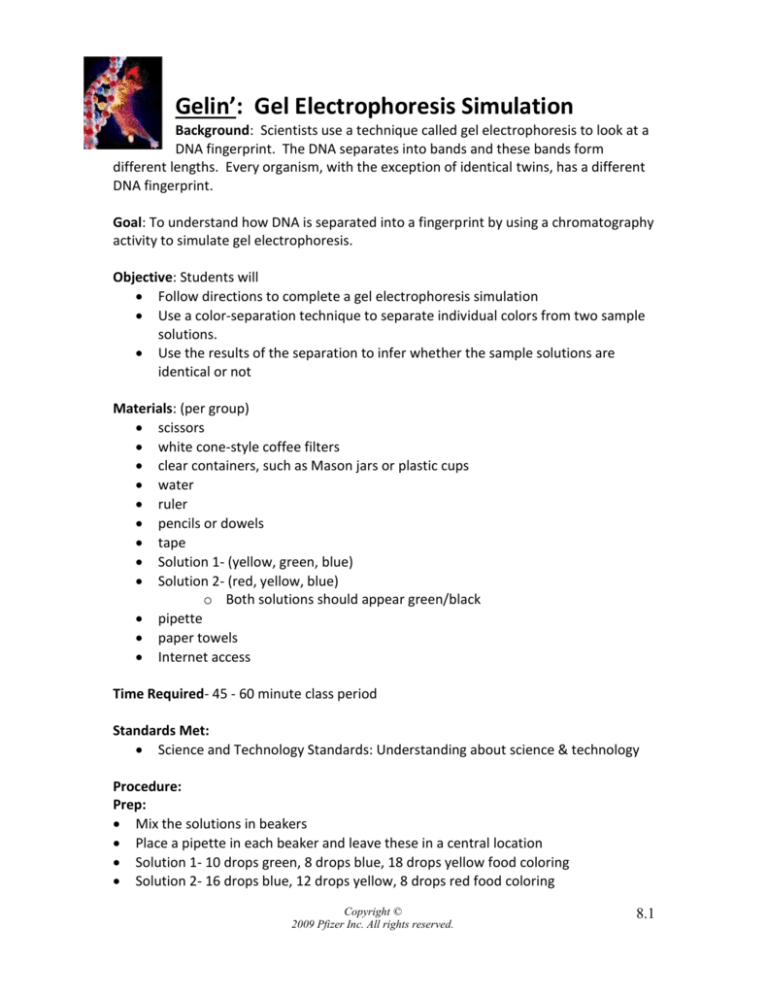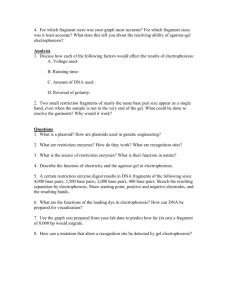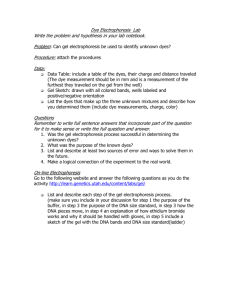
Gelin’: Gel Electrophoresis Simulation
Background: Scientists use a technique called gel electrophoresis to look at a
DNA fingerprint. The DNA separates into bands and these bands form
different lengths. Every organism, with the exception of identical twins, has a different
DNA fingerprint.
Goal: To understand how DNA is separated into a fingerprint by using a chromatography
activity to simulate gel electrophoresis.
Objective: Students will
Follow directions to complete a gel electrophoresis simulation
Use a color-separation technique to separate individual colors from two sample
solutions.
Use the results of the separation to infer whether the sample solutions are
identical or not
Materials: (per group)
scissors
white cone-style coffee filters
clear containers, such as Mason jars or plastic cups
water
ruler
pencils or dowels
tape
Solution 1- (yellow, green, blue)
Solution 2- (red, yellow, blue)
o Both solutions should appear green/black
pipette
paper towels
Internet access
Time Required- 45 - 60 minute class period
Standards Met:
Science and Technology Standards: Understanding about science & technology
Procedure:
Prep:
Mix the solutions in beakers
Place a pipette in each beaker and leave these in a central location
Solution 1- 10 drops green, 8 drops blue, 18 drops yellow food coloring
Solution 2- 16 drops blue, 12 drops yellow, 8 drops red food coloring
Copyright ©
2009 Pfizer Inc. All rights reserved.
8.1
Pass out DNA Fingerprint Activity Sheet to each group
Provide all the necessary materials
Monitor as the class completes the activity
Point out to students that they have just completed the same biotechnology lab as
the technicians at Furry Friends.
Furry Friends has sent over pictures of the results of the gel electrophoresis
fingerprints for potential fathers
Have students get out medical file and turn to the medical expense sheet. The
charge for receiving one DNA gel electrophoresis fingerprint is $30.00. Students
should add the cost to their sheets.
Give each group a copy of their first choice from yesterday’s Daddy Data Sheet. Also
give a copy of the kitten’s DNA gel electrophoresis fingerprint.
Students should compare the DNA gel electrophoresis fingerprints to determine if it
is a match and reveal the identity of the father.
If it is not a match, students are charged an additional $30.00 and will receive the 2nd
choice DNA fingerprint.
Assessment:
Participation in the lab activity
Accurate completion of lab questions
Cells and Heredity, Evanston, Illinois: McDougal Littell, a Houghton Mifflin Company.
Copyright ©
2009 Pfizer Inc. All rights reserved.
8.2
Gelin’: Student Sheet
Problem: How can similar substances be separated so that they can be identified?
Materials: Gather the following materials for your group
2 coffee filters
1 scissors
2 jars
2 pencils
1 graduated cylinder
1 ruler
Procedure:
1. Cut the seam off the coffee filters and open it flat. Cut a strip about 2cm wide from the
widest part of the filter. You need two strips.
2. Write 1 on the top one strip and 2 on the top of the second strip
3. Fill the containers with 50 ml of water
4. Tape the top of each strip to the pencil
*complete the “color of solution” column in the table below.
5. Place one small drop of Solution 1 about 2 cm from the bottom of the strip labeled 1.
6. Place 1 small drop of Solution 2 about 2 cm from the bottom of the strip labeled 2.
7. Fill out the observation and hypothesis chart.
8. Carefully lower the strip into the container so that 3to 5 mm of the end of the strip is in the
water. Do not allow the part of the strip with the color drop to touch the water. If necessary,
re-tape the strip on the pencil. Rest the pencil on the rim of the jar.
9. Repeat procedure # 8 for strip #2
10. Observe your setups for 15 to 20 minutes. Then remove the strips from the containers and
lay them on a paper towel.
Observation and Hypothesis Table
Color of Solution
Solution 1
What colors are in the solution
Solution 2
Copyright ©
2009 Pfizer Inc. All rights reserved.
8.3
Gelin’: Simulation Analysis
1. What happened to the dots of solution on each of the strips as the water traveled up
the strip? Draw and describe the color patterns on each strip.
2. Compare your test to actual gel electrophoresis steps you saw in the video. How are
the tests similar and different?
Copyright ©
2009 Pfizer Inc. All rights reserved.
8.4
Gelin’: Gel Electrophoresis Simulation
Analysis Teacher Key
Observation and Hypothesis Table
Color of Solution
What colors are in the solution
Solution 1
Blackish Green
Yellow
Green
Blue
Blackish Green
Red
Yellow
Blue
Solution 2
1. What happened to the dots of solution on each of the strips as the water traveled up
the strip? Draw and describe the color patterns on each strip.
Answers will vary, but may include:
As the water travels up the strips, the solution starts to separate. The lighter colors
travel more quickly so they move farther up the strip. The darker colors form bands
closer to the starting point.
2. Compare your test to actual gel electrophoresis steps you saw in the video. How are
the tests similar and different?
Answers will vary, but may include:
They are similar that both the DNA and color solutions separate according to how
quickly they move across the gel or paper strip.
You don’t need to stain the paper to see the results. No electric current was used.
Copyright ©
2009 Pfizer Inc. All rights reserved.
8.5




![Student Objectives [PA Standards]](http://s3.studylib.net/store/data/006630549_1-750e3ff6182968404793bd7a6bb8de86-300x300.png)




